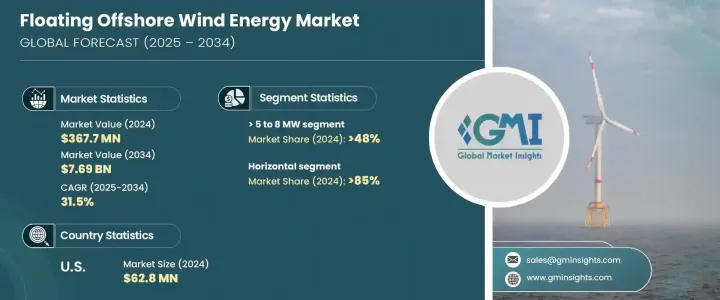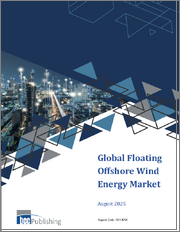
|
시장보고서
상품코드
1699398
부유식 해상 풍력에너지 시장 기회, 성장 촉진요인, 산업 동향 분석 및 예측(2025-2034년)Floating Offshore Wind Energy Market Opportunity, Growth Drivers, Industry Trend Analysis, and Forecast 2025-2034 |
||||||
해상 풍력에너지 세계 시장은 2024년 3억 6,770만 달러로 평가되었고, 2025-2034년 연평균 31.5%의 성장률로 꾸준히 확대될 것으로 예상됩니다.
시장의 급격한 성장은 기술별 할당, 관세 설정, 산업 강화를 위한 경쟁 입찰 등 유리한 정부 정책에 힘입은 바 있습니다. 많은 국가들이 재생에너지 솔루션에 대한 세계 수요 증가에 대응할 수 있는 잠재력을 인식하고 부유식 해상풍력 프로젝트 개발을 가속화하기 위한 전략을 적극적으로 시행하고 있습니다. 전 세계가 청정 에너지로 전환하면서 각국이 탄소중립 목표를 달성하기 위해 노력하는 가운데 해상풍력 기술에 대한 투자에 탄력이 붙고 있습니다.

부유식 해상 풍력 발전 기술은 기존의 고정식 풍력 발전 단지와 관련된 몇 가지 문제, 특히 기존의 설치가 불가능한 깊은 수심 지역에서 실행 가능한 해결책을 제시합니다. 심해에서 더 강력하고 안정적인 풍력 자원을 이용할 수 있다는 것은 큰 장점이며, 부유식 풍력 발전소를 대규모 발전의 매력적인 선택으로 만들고 있습니다. 재료 과학, 터빈 효율, 부유식 플랫폼 설계의 끊임없는 발전으로 인해 비용이 낮아지고 전 세계 개발자들이 더 쉽게 이용할 수 있는 기술이 될 것으로 예상됩니다. 또한, 에너지 안보에 대한 우려가 커지면서 정부와 기업들은 에너지 자원을 다양화하고 화석 연료에 대한 의존도를 낮추기 위한 장기적인 해결책으로 해상 풍력 발전에 대한 관심이 높아지고 있습니다.
| 시장 범위 | |
|---|---|
| 시작 연도 | 2024년 |
| 예측 연도 | 2025-2034년 |
| 시작 금액 | 3억 6,770만 달러 |
| 예상 금액 | 76억 9,000만 달러 |
| CAGR | 31.5% |
2024년 수평부유식 해상풍력 터빈은 85% 시장 점유율을 차지할 것으로 예상됩니다. 이 부문의 리더십은 고효율, 간소화된 생산 공정, 유지보수의 용이성 등으로 인해 개발자들에게 선호되는 선택이 되고 있습니다. 이 분야는 부유식 플랫폼의 설계 및 성능 향상을 위한 연구개발에 많은 투자가 이루어지고 있습니다. 재료 및 제조 기술의 지속적인 개선으로 부유식 풍력 터빈의 비용 효율성과 내구성이 향상되어 이러한 시스템에 대한 수요가 더욱 증가하고 있습니다.
부유식 해상풍력 시장은 터빈 용량에 따라 2MW 이상부터 12MW 이상까지 세분화되어 있으며, 10-12MW 이상 카테고리가 가장 빠르게 성장할 것으로 예상되며 2034년까지 연평균 54%의 연평균 복합 성장률(CAGR)을 나타낼 것으로 예측됩니다. 업계가 터빈의 대형화 및 고효율화에 집중하는 것은 전체 에너지 생산 비용을 낮추는 데 매우 중요합니다. 더 큰 용량의 터빈을 개발함으로써 기업은 더 적은 수의 유닛으로 더 많은 전력을 생산할 수 있게 되어 비용을 크게 절감할 수 있습니다. 최첨단 터빈 설계, 첨단 제어 시스템, 혁신적인 소재에 대한 막대한 투자가 이 시장 부문의 성장을 더욱 촉진하고 있습니다.
북미 부유식 해상풍력 시장은 2024년 6,280만 달러 규모 시장을 창출할 것으로 예상됩니다. 이 분야는 재생 가능 에너지 프로젝트를 촉진하는 정부의 지원적인 규제와 인센티브에 힘입어 빠르게 성장하고 있습니다. 터빈 가격이 하락하고 업계의 생산 능력이 확대됨에 따라 부유식 해상 풍력발전에 대한 수요는 지속적으로 증가하고 있습니다. 미국은 세계 에너지 전환의 중요한 기업로 부상하고 있으며, 재생 가능 에너지 목표를 달성하고 청정 에너지 전망에서 입지를 강화하기 위해 해상 풍력에너지에 많은 투자를 하고 있습니다.
목차
제1장 조사 방법과 조사 범위
제2장 주요 요약
제3장 업계 인사이트
- 업계 에코시스템
- 규제 상황
- 업계에 대한 영향요인
- 성장 촉진요인
- 업계의 잠재적 리스크&과제
- 성장 가능성 분석
- 가격 동향 분석
- Porter's Five Forces 분석
- PESTEL 분석
제4장 경쟁 구도
- 서론
- 전략 대시보드
- 혁신 및 기술 전망
제5장 시장 규모와 예측 : 터빈 정격별, 2021년-2034년
- 주요 동향
- 2MW 이하
- 2-5MW
- 5-8MW
- 8-10MW
- 10-12MW
- 12MW 이상
제6장 시장 규모와 예측 : 축별, 2021년-2034년
- 주요 동향
- 수평
- Up-wind
- Downwind
- 수직
제7장 시장 규모와 예측 : 컴포넌트별, 2021년-2034년
- 주요 동향
- 블레이드
- 타워
- 기타
제8장 시장 규모와 예측 : 깊이별, 2021년-2034년
- 주요 동향
- 30m 이하
- 30m-50m
- 50m 이상
제9장 시장 규모와 예측 : 지역별, 2021년-2034년
- 주요 동향
- 북미
- 미국
- 캐나다
- 유럽
- 독일
- 영국
- 프랑스
- 스웨덴
- 폴란드
- 덴마크
- 포르투갈
- 아일랜드
- 벨기에
- 아시아태평양
- 중국
- 인도
- 일본
- 한국
- 베트남
- 세계 기타 지역
제10장 기업 개요
- Equinor ASA
- General Electric
- Global Energy(Group) Limited
- Hexicon
- Nexans
- Ørsted
- Prysmian Group
- RWE
- Sumitomo Electric Industries
- Simply Blue Group
- Siemens Gamesa Renewable Energy
- Vattenfall AB
- Vestas
The Global Floating Offshore Wind Energy Market was valued at USD 367.7 million in 2024 and is projected to expand at a robust CAGR of 31.5% from 2025 to 2034. The market's rapid growth is fueled by favorable government policies, including technology-specific quotas, set tariffs, and competitive auctions designed to strengthen the industry. Many countries are actively implementing strategies to accelerate the deployment of floating offshore wind projects, recognizing their potential in addressing the world's increasing demand for renewable energy solutions. With the global shift toward clean energy, investments in offshore wind technology are gaining momentum as nations strive to meet ambitious carbon neutrality goals.

Floating offshore wind technology presents a viable solution to several challenges associated with traditional fixed-bottom wind farms, particularly in regions with deep waters where conventional installations are not feasible. The ability to harness stronger and more consistent wind resources in deep-sea locations is a significant advantage, making floating wind farms an attractive option for large-scale power generation. Continuous advancements in material sciences, turbine efficiency, and floating platform designs are expected to drive down costs, making the technology more accessible to developers worldwide. Additionally, as energy security concerns grow, governments and corporations are increasingly looking toward offshore wind as a long-term solution to diversify energy sources and reduce dependency on fossil fuels.
| Market Scope | |
|---|---|
| Start Year | 2024 |
| Forecast Year | 2025-2034 |
| Start Value | $367.7 Million |
| Forecast Value | $7.69 Billion |
| CAGR | 31.5% |
In 2024, the horizontal floating offshore wind turbine segment accounted for a dominant market share of 85%. This segment's leadership can be attributed to its high efficiency, streamlined production processes, and ease of maintenance, making it a preferred choice for developers. The sector is witnessing significant investment in research and development to enhance floating platform design and performance. With continuous improvements in materials and manufacturing techniques, floating wind turbines are becoming more cost-effective and durable, driving further demand for these systems.
The floating offshore wind energy market is categorized based on turbine capacity, with segments ranging from >2 MW to >12 MW. The >10 to 12 MW category is expected to register the fastest growth, projected at a CAGR of 54% through 2034. The industry's focus on increasing turbine size and efficiency is critical in lowering overall energy production costs. By developing higher-capacity turbines, companies can generate more electricity with fewer units, leading to substantial cost reductions. Significant investments in cutting-edge turbine designs, advanced control systems, and innovative materials are further propelling this market segment's growth.
North America floating offshore wind energy market generated USD 62.8 million in 2024. The sector is experiencing accelerated expansion due to supportive government regulations and incentives promoting renewable energy projects. As turbine prices decline and industry capacity expands, demand for floating offshore wind energy continues to rise. The United States is emerging as a key player in the global energy transition, investing heavily in offshore wind energy to meet its renewable energy targets and strengthen its position in the clean energy landscape.
Table of Contents
Chapter 1 Methodology & Scope
- 1.1 Research design
- 1.2 Base estimates & calculations
- 1.3 Forecast model
- 1.4 Primary research & validation
- 1.4.1 Primary sources
- 1.4.2 Data mining sources
- 1.5 Market definitions
Chapter 2 Executive Summary
- 2.1 Industry 3600 synopsis, 2021 – 2034
Chapter 3 Industry Insights
- 3.1 Industry ecosystem
- 3.2 Regulatory landscape
- 3.3 Industry impact forces
- 3.3.1 Growth drivers
- 3.3.2 Industry pitfalls & challenges
- 3.4 Growth potential analysis
- 3.5 Price trend analysis
- 3.6 Porter's analysis
- 3.6.1 Bargaining power of suppliers
- 3.6.2 Bargaining power of buyers
- 3.6.3 Threat of new entrants
- 3.6.4 Threat of substitutes
- 3.7 PESTEL analysis
Chapter 4 Competitive landscape, 2024
- 4.1 Introduction
- 4.2 Strategic dashboard
- 4.3 Innovation & technology landscape
Chapter 5 Market Size and Forecast, By Turbine Rating, 2021 – 2034 (USD Million & MW)
- 5.1 Key trends
- 5.2 ≤ 2 MW
- 5.3 >2 to 5 MW
- 5.4 >5 to 8 MW
- 5.5 >8 to 10 MW
- 5.6 >10 to 12 MW
- 5.7 > 12 MW
Chapter 6 Market Size and Forecast, By Axis, 2021 – 2034 (USD Million & MW)
- 6.1 Key trends
- 6.2 Horizontal
- 6.2.1 Up-wind
- 6.2.2 Downwind
- 6.3 Vertical
Chapter 7 Market Size and Forecast, By Component, 2021 – 2034 (USD Million & MW)
- 7.1 Key trends
- 7.2 Blade
- 7.3 Tower
- 7.4 Others
Chapter 8 Market Size and Forecast, By Depth, 2021 – 2034 (USD Million & MW)
- 8.1 Key trends
- 8.2 ≤ 30 m
- 8.3 >30 m to ≤ 50 m
- 8.4 > 50 m
Chapter 9 Market Size and Forecast, By Region, 2021 – 2034 (USD Million & MW)
- 9.1 Key trends
- 9.2 North America
- 9.2.1 U.S.
- 9.2.2 Canada
- 9.3 Europe
- 9.3.1 Germany
- 9.3.2 UK
- 9.3.3 France
- 9.3.4 Sweden
- 9.3.5 Poland
- 9.3.6 Denmark
- 9.3.7 Portugal
- 9.3.8 Ireland
- 9.3.9 Belgium
- 9.4 Asia Pacific
- 9.4.1 China
- 9.4.2 India
- 9.4.3 Japan
- 9.4.4 South Korea
- 9.4.5 Vietnam
- 9.5 Rest of World
Chapter 10 Company Profiles
- 10.1 Equinor ASA
- 10.2 General Electric
- 10.3 Global Energy (Group) Limited
- 10.4 Hexicon
- 10.5 Nexans
- 10.6 Ørsted
- 10.7 Prysmian Group
- 10.8 RWE
- 10.9 Sumitomo Electric Industries
- 10.10 Simply Blue Group
- 10.11 Siemens Gamesa Renewable Energy
- 10.12 Vattenfall AB
- 10.13 Vestas



















